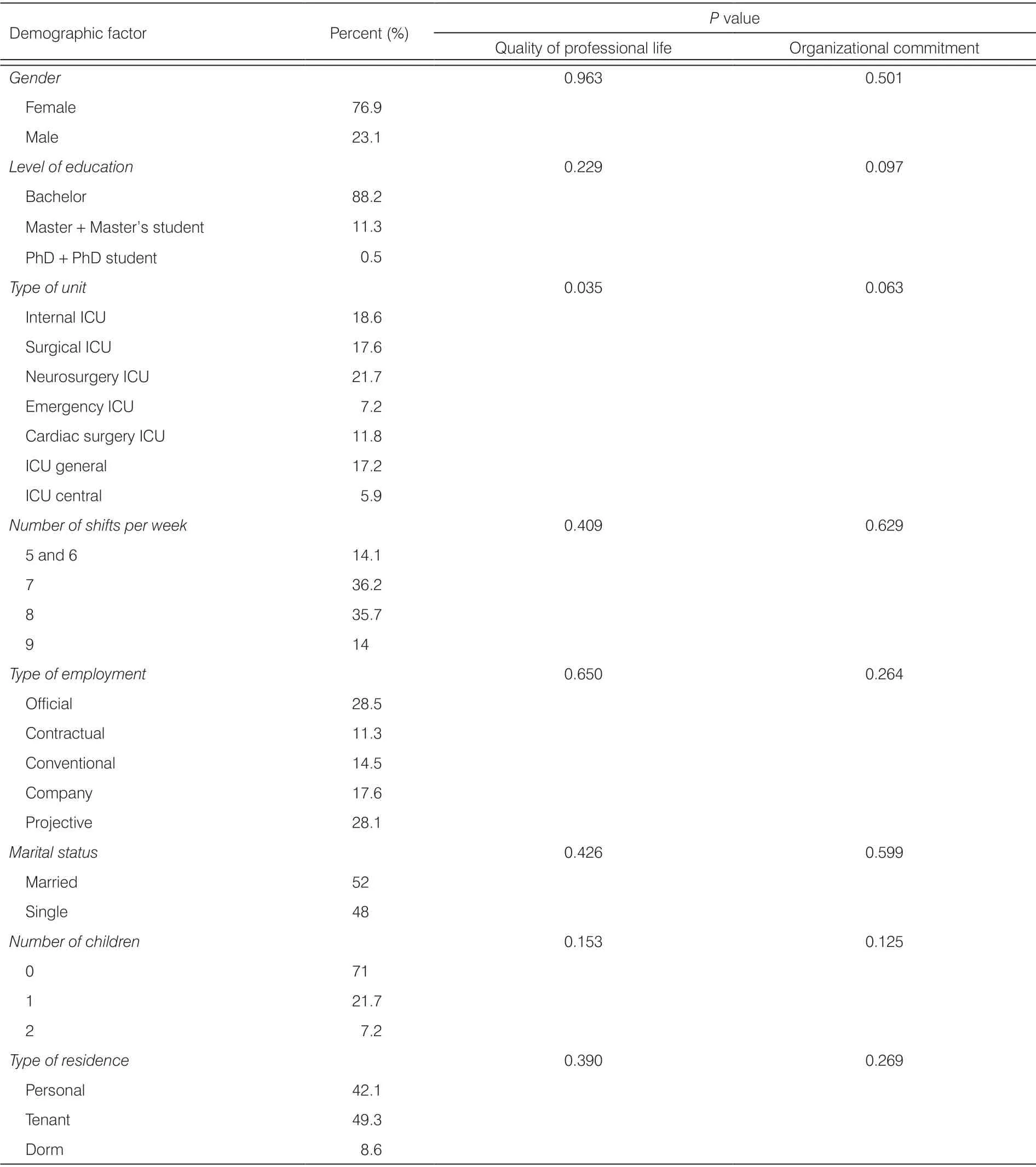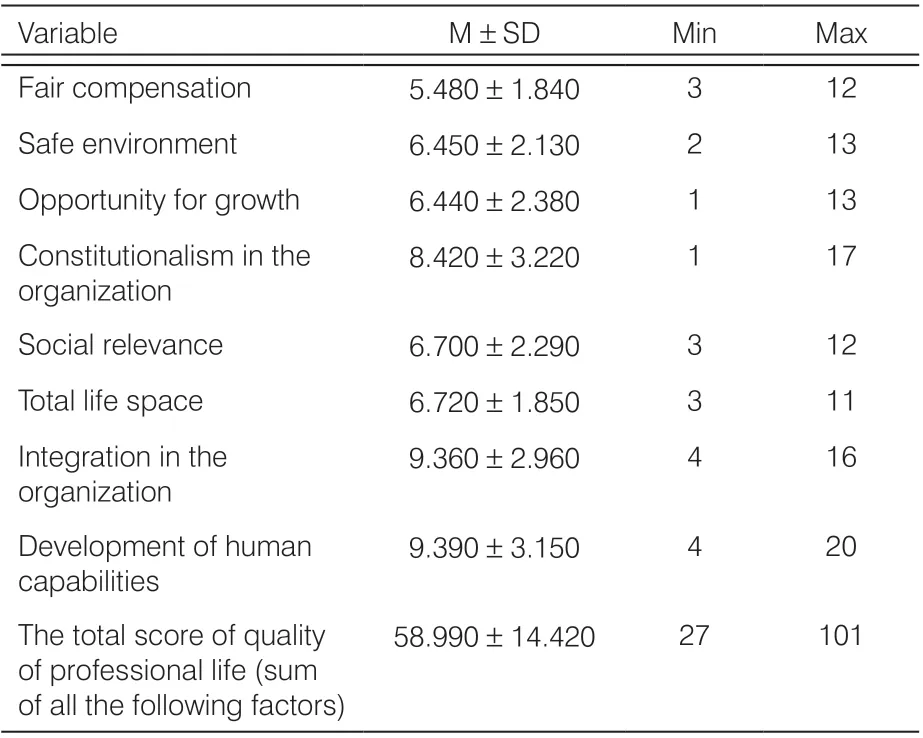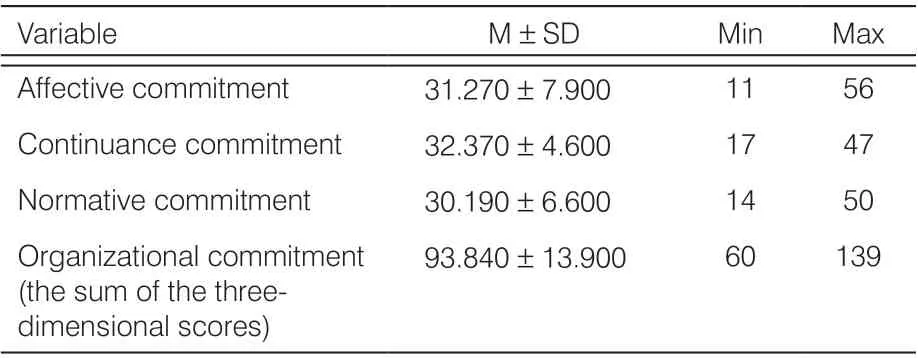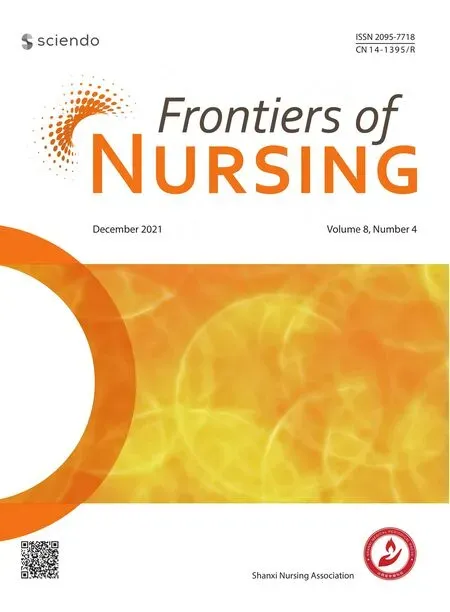Relationship between quality of professional life and organizational commitment in intensive care unit nurses
Mhooeh Mghrei, Zint Mohei,*, Soheil Jfri
aDepartment of Nursing, School of Nursing and Midwifery, Shiraz University of Medical Sciences, Shiraz, Iran bStudent Research Committee, Shiraz University of Medical Sciences, Shiraz, Iran
Abstract: Objective: The quality of professional life has attracted the attention of many managers owing to its importance, and organizational commitment differs according to work conditions in an organization. As the largest professional group in the healthcare system,nurses face many stressful factors that can endanger their quality of professional life and organizational commitment. Despite their huge importance, these 2 variables have rarely been addressed or evaluated in the nursing profession. The present study was conducted to determine the relationship between quality of professional life and organizational commitment in nurses working in the intensive care units (ICUs) and critical care units (CCUs).
Keywords: quality of professional life • organizational commitment • nurses • ICU • CCU
1. Introduction
Healthcare organizations hold a special position in the community owing to their key role in disease prevention,care, and treatment.1As a key component of the health system, hospitals seek to optimally use resources,given the increasing costs and scarcity of resources.2Nurses play a major role in sensitive hospital wards such as intensive care units (ICUs), which are equipped with state-of-the-art technologies and facilities required for the care of critically ill patients.3Being in a lifethreatening condition, patients in ICUs need continuous monitoring by specialists and trained nurses for diagnosis, management, and care. These nurses should have ample knowledge of physiological warning signs and be able to appropriately respond to rapid changes in patient status.3Empowering nurses as an important human resource of hospitals reduces occupational stress and promotes organizational commitment and trust, productivity, participation in decision-making, quality care, patient satisfaction, self-sufficiency, a sense of independence, self-confidence, accountability, and ultimately organizational effectiveness. Moreover, levels of job satisfaction, motivation, and organizational loyalty are higher in empowered staff in such a way that they tend to involve themselves more in achieving organizational goals.4
Human resources are considered the most valuable asset in organizations. Paying attention to the needs of the staff and their psychophysical health and improving the quality of their professional life is therefore crucial for increasing the productivity and efficiency of organizations.5Quality of professional life refers to actual work conditions in an organization such as wages and benefits, welfare facilities, health and safety measures,participation in decision-making, and work management methods. The perception of staff of their job is specifically explained by the quality of professional life,6which is evaluated as a criterion for occupational performance according to their psychosocial characteristics and the degree to which they adapt to work conditions.7High quality of professional life is essential for organizations that prioritize recruiting and retaining their personnel.On the other hand, poor quality of professional life is a major problem that affects all the personnel irrespective of their position and situation and indirectly damages their morale and increases their absenteeism,desertion, and mental stress by causing fatigue and job dissatisfaction.8
With a sublime position in organizational behaviors,organizational commitment refers to the strong desire of a member to remain in the organization, their tremendous efforts to achieve organizational goals, and their firm belief in organizational values and objectives.9According to Cohen, high organizational commitment results in useful outcomes, including enhanced performance effectiveness and productivity and reduced desire for desertion and absenteeism at individual and organizational levels.10Identifying the factors and features that improve commitment, therefore, appears worthwhile for organizations.11The organizational factors that improve organizational commitment include the high quality of professional life and job security.12Increasing commitment and accountability in human resources is particularly important in health organizations, as the clients of these organizations themselves constitute the human resources of other organizations.13At the forefront of health care, nurses not only should provide excellent levels of patient care but also should have to play an active role in proceeding with major organizational tasks.14Having the perception that the organization has adequately contributed to their support and welfare helps nurses work effectively and make greater efforts to cope with stressful circumstances. Benefiting from factors such as industry-standard salaries, proper retirement plans, frequent merit-based promotions,greater availability of leave, and rewards for exceeding established standards of performance improves organizational commitment and the desire to stay.15
The heavy workload of ICU nurses associated with psychophysical pressure is caused by taking care of critically ill patients, working shifts, their high number of working hours, a lack of auxiliary workforce, and using advanced care equipment.
Given the effect of the heavy workload on quality of professional life and organizational commitment in ICU nurses and the failure to concurrently investigate these 2 variables in ICU and critical care unit (CCU) nurses in the literature, the present study was conducted to determine the relationship between quality of professional life and organizational commitment in ICU nurses and provide managers with the necessary support, counseling,and treatment.
2. Methods
The present descriptive, analytical, and cross-sectional study was conducted from 2018 to 2019 on a population comprising 530 clinical staff working in adult ICUs and CCUs of 3 hospitals affiliated to Shiraz University of Medical Sciences. The sample size, based on the findings of the study of Mehdad et al,16was calculated as 221 in MedCalc (MD Aware, LLC, New York, United States)with a 90% test power and a 5% alpha error.Structural equation modeling was used to explain the relationships among the variables. The sample size in each hospital was then determined using proportional to size cluster sampling. The inclusion criteria comprised willingness to participate in the study, having a minimum of bachelor’s degree in nursing, having >1 year of work experience in ICUs, and being a clinical nurse rather than a manager.
The data were collected using the following three questionnaires:
(1) Demographic questionnaire: The study subjects completed this questionnaire, which comprised personal and occupational details, including age, gender, level of education (from bachelor to PhD), type of CCUs or ICUs, the number of shifts per week, type of employment, years of work experience, amount of income, marital status,the number of children, and type of residence(personal, tenant, and so on). This questionnaire was developed according to previous studies and expert comments.
(2) The quality of work-life questionnaire based on an 8-component model was proposed by Walton:This 27-item questionnaire was used to measure 8 dimensions, i.e., adequate and fair compensation, safe and healthy working environment, providing an opportunity for continued growth and security, constitutionalism in the organization,the social relevance of work-life, total life span,social unity, and integration and development of human capabilities. The items were scored on a 5-point Likert scale ranging from 1 (very low)to 5 (very high) [8] with scores of 27–45, 46–90,and more than 91 suggesting the poor quality,moderate quality, and high quality of professional life, respectively.17In 1973, Walton18confirmed the construct validity of this questionnaire by calculating a coefficient value of 0.780 and its reliability by calculating a Cronbach alpha value of 0.850. Hadizadeh Talasaz et al19also confirmed the validity of this questionnaire by reporting an internal consistency coefficient value of 0.920 and its reliability by calculating a Cronbach alpha value of 0.830.
(3) The organizational commitment scale: This 24-item questionnaire was introduced by Allen and Meyer20in 1990, which comprised 3 dimensions, i.e., affective commitment, continuance commitment, and normative commitment. The items were scored on a 7-point Likert scale ranging from 7 (completely agree) to 1 (completely disagree), with higher scores denoting higher commitment and the total score being 24–168.20,21A total score of 24–72, 73–121,and 122–168 showed low commitment, moderate commitment, and high commitment, respetively.22In 1990, Allen and Meyer20determined a reliability coefficient value of 0.870 for affective commitment, 0.750 for continuance commitment,and 0.790 for normative commitment. Moreover,Makarem et al.23confirmed the face and content validity of this scale, as well as its reliability, by calculating a Cronbach alpha value of 0.706.
The data collected were analyzed in SPSS,version24 (IBM Corp. Released 2016. IBM SPSS Statistics for Windows, version 24.0. Armonk, NY: IBM Corp.),using descriptive statistics, including relative frequency,frequency and mean, and inferential statistics such as the independentttest, Analysis of Variance (ANOVA),and the Pearson correlation coefficient. The level of statistical significance was set asP< 0.050 and the confidence interval as 95%. The Kolmogorov–Smirnov test was also performed before conducting the statistical tests to investigate the distribution normality of the data.
3. Results
The mean age of the 221 participating nurses was 30.630 ± 5.140 years, their mean work experience was 6.900 ± 5.240 years, and most of them had a monthly salary of 30 ± 0.41 million Iranian rial (IRR). Moreover,76.90% of them were women, 52% married, 71% childless, 49.30% tenants, and 28.50% officially employed,while 88.20% had a bachelor’s degree and 93.20%worked shifts. More than 70% of the nurses also worked 7–8 shifts a week (Table 1).
According to Table 2, the total mean score of quality of professional life was 58.990 ± 14.420 in the nurses and that score was high in 35 (15.80%), moderate in 184 (83.30%), and low in 2 (0.90%) nurses. According to Table 3, the total mean score of organizational commitment was 93.840 ± 13.900 and this score was high in 11 (5%), moderate in 200 (90.50%), and low in 10(4.50%) nurses.
The present study found that the main study variables, i.e., quality of professional life and organizational commitment, are not associated with age, gender, level of education, number of shifts, type of shift, number of children, type of residence, type of employment, and work experience. Significant relationships were, however, observed between the type of unit and quality of professional life (P= 0.030). Table 2 presents the mean scores of quality of professional life and its dimensions,with the development of human capabilities receiving the highest score of 9.390 ± 3.100 and adequate and fair compensation receiving the lowest score of 5.480 ± 1.800. The mean score of quality of professional life, obtained as 58.990 ± 14.420, was also categorized as moderate (Table 2).
According to Table 3, normative commitment received the lowest score and continuance commitment received the highest score. The score of organizational commitment with a mean of 93.840 ± 13.900 was also moderate.
The Pearson test showed positive and significant relationships between quality of professional life and organizational commitment (r= 0.39,P< 0.001) (Table 4).

Table 1. Frequency percentage of demographic variables and their relationship with quality of professional life and organizational commitment.
4. Discussion
The present study was conducted to determine the relationship between quality of professional life and organizational commitment in ICU and CCU nurses.The findings suggested moderate levels for quality of professional life in these nurses (total score = 58.990),which is consistent with previous findings reported in the literature.6,8,9Research conducted in Iran, such as a study by Bakhshi et al.,8also suggested the moderate quality of professional life in healthcare workers. Paying attention to the dimensions of quality of professional lifeand the factors improving it is therefore crucial. Moreover, Kelbiso et al.24found the quality of professional life to be low and moderate in the majority of participants and high in 32.80%. Furthermore, Almalki et al.25found the participants to be dissatisfied with their quality of professional life. These discrepancies in results can be explained by differences in organizational management in different countries and the financial status, workplace environment, and psychological characteristics of 2 different communities.

Table 2. The mean score of quality of professional life and its dimensions in nurses of ICUs.

Table 3. The mean score of organizational commitment and its dimensions in nurses of ICUs.
The present study found a high quality of professional life in 2 (0.90%) of the nurses, which is almost consistent with the results obtained by Sakkaki et al.26,who reported a high quality of professional life in none of the 85 participants. This might have been caused by the exposure of ICU and CCU nurses to emergency and unexpected situations and high levels of workplace noise and timings of their shift works, long working hours, disproportionate salary to responsibility, heavy workload, and high stress levels, which can affect their perception of the quality of professional life.

Table 4. The relationship between quality of professional life and organizational commitment in nurses of ICUs (the Pearson test).
The present study reported moderate levels for organizational commitment (score = 93.840), which is consistent with the majority of studies conducted in Iran and other countries.22,27,28The poor organizational and occupational factors, including organizational justice,job satisfaction, job safety and security, organizational conflict, and burnout reported in the literature can justify the moderate organizational commitment in nurses in Iran. Improving organizational commitment is crucial, given its effect on the occupational performance of staff and that unfavorable organizational commitment is associated with consequences such as desertion by nurses, which can seriously disrupt hospital activities.22
The mean scores of dimensions of organizational commitment are 32.37% for continuance commitment,31.27% for affective commitment, and 30.19% for normative commitment; it seems that continuance commitment is the best predictor of organizational commitment,followed by affective commitment and normative commitment. Continuance commitment suggests that employees accumulate capital in the organization, and the longer their stay in the organization, the more capital they can accumulate, which makes losing it costly.29Continuance commitment, therefore, reflects the cost of leaving the organization versus the benefits of staying,and employees with continuance commitment are highly likely to avoid leaving their organization and joining a new organization as a result of comparing the investments and benefits of the new job with those of their current occupation.30Normative commitment received the lowest score in the present study. Normative commitment refers to a sense of responsibility in employees for the investment made in them by the organization.Employees with normative commitment tend to remain committed and serve the organization unless their duties are discharged and they get legally and ethically relieved.30
The present study found the highest level of commitment in the staff to be associated with their continuance commitment, which is consistent with the results of a study by Abbaszadeh et al. in nurses.29Veličković et al.31found the score of affective commitment to be the highest in nurses in Serbia compared to that of other dimensions. Roohi et al.32found the score of normative commitment to be the highest compared to the scores of other dimensions of organizational commitment,which is inconsistent with the present findings. Ebadi et al.33and Delgoshaei et al.,34however, found affective commitment in nurses to receive the highest score compared to the scores of other dimensions of organizational commitment. These differences in organizational commitment can be attributed to personal, organizational, and non-organizational factors. Although effective commitment appears to emotionally link employees to the organization, continuance commitment is more effective in securing their commitment to the organization. Employees who observe that ethical values are observed in organizational decision-making are more willing to stay with their organization, especially when they feel their personal ethical values are compatible with those of the organization.29
The result of the present study shows positive and significant relationships between quality of professional life and organizational commitment, which is consistent with the findings obtained by Eren and Hisar,35Zarei et al.,9Hadizadeh Talasaz et al.,19and Hashempour et al.36
The correlation between organizational commitment and quality of professional life suggests a mutual relationship between these variables in a way that increasing or decreasing either one, respectively,increases or decreases the other. The potentially significant effect of quality of professional life on organizational commitment in employees can result in certain favorable behaviors in the organization and increase efficiency and effectiveness. To improve attachment and commitment to the organization in their employees,organizational managers should therefore pay special attention to the quality of professional life and take measures to enhance it. On the other hand, the damage caused by failing to pay attention to organizational commitment makes employees find ways to satisfy their needs, which often contradicts collective interests, disrupts social relationships, and creates a vicious circle.
5. Conclusions
The findings of the present study indicated the presence of positive and significant correlations between quality of professional life and organizational commitment.Organizational managers are therefore recommended to adopt policies and measures in a way that their employees find their workplace more favorable and their commitment to the organization strengthened. These programs include providing support by the management, improving supervision, holding training sessions,observing organizational justice, making efforts for fair payments, and striking a balance between work and life through increasing availability of leave, providing recreational and sports facilities, and improving the physical condition of the workplace.
Limitation
The limitations of the present study included the potential bias in the responses of the nurses, which was caused by their spiritual status, and prevailed despite the fact that they were suitably briefed on the study objectives before distribution of the questionnaires. Furthermore, the potential effect of personal differences between the study subjects on their perception of the quality of professional life was beyond the researcher’s control. Further studies are therefore recommended to be conducted using more accurate methods, such as semi-structured in-depth interviews through qualitative research, to investigate the quality of professional life and organizational commitment in nurses.
Acknowledgments
The present article was extracted from a master’s thesis on Adult Critical Care Nursing by Soheila Jafari in the School of Nursing and Midwifery supervised by Mahbobeh Mogharei. This article is approved and financially supported by the Ethics Committee of Shiraz University of Medical Sciences on 28 March 2018 (code:97-17144). The authors would like to express their gratitude to the authorities of the Deputy of Research of Shiraz University of Medical Sciences and the ICU nurses of teaching hospitals affiliated with this university for their cooperation.
Ethical approval
The study protocol was approved by the Ethics Committee of Shiraz University of Medical Sciences (code:970108-17144), and the researcher presented to the study setting and made the necessary arrangements with the relevant authorities, then introduced himself to the participants, briefed them on the study objectives,ensured their right to withdraw from the study at their own discretion, obtained their written consent, and distributed the questionnaires among them.
Conflicts of interest
All contributing authors declare no conflicts of interest.
- Frontiers of Nursing的其它文章
- Predictors of nurse’s happiness:a systematic review
- Redefining the concept of professionalism in nursing: an integrative review
- Clinical nursing competency assessment:a scoping review
- Moderating effect of psychological resilience on the perceived social support and loneliness in the left-behind elderly in rural areas†
- Effects of progressive muscular relaxation and stretching exercises combination on blood pressure among farmers in rural areas of Indonesia: a randomized study†
- Visualization analysis of research“hot spots”: self-management in breast cancer patients†

